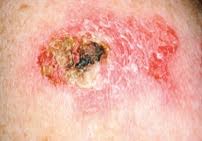June 7, 2017 | Stephen Fine, Founder and President
Squamous Cell Carcinoma
Unlike melanoma, Squamous Cell Carcinoma (SCC) (SQUAY-muss) is a fairly-common type of skin cancer that is not typically fatal. Just like melanoma though, if it’s left undiagnosed, it too can turn lethal.
Squamous Cell Carcinoma can originate in any of the body’s numerous squamous cells. You may not be too surprised to learn that those cells are where this form of skin cancer gets its name. As with many such cancers, its primary cause is overexposure of unprotected skin to the sun’s harmful UV rays.
It can also be developed after tanning bed use. As an aside, there are no words strong enough to sufficiently emphasize the importance of avoiding those beds. This also includes lamps used for things like securing gel nail polish. Any commercial use of artificial UV light is a 100% Risk-0% Reward activity. Any dermatologist will attest that that is not in any way hyperbole.
SCC usually develops on the areas of our skin that are most likely to incur unprotected sun exposure; such as on the scalp, ears, lips and the backs of hands.
How deadly it might become can also be determined by the area on which it begins. The mortality rate climbs when it’s located on the lips, in the mouth, over the carotid artery, or on skin covering internal organs such as the lungs.
As with melanoma, SCC can present with a variety of appearances. However, what it looks like most often is a slightly raised red patch that becomes rough, dry and scaly.
Presented below are two pictures. On the left is an example of SCC. The picture to its right depicts Actinic Keratosis, which we’ll discuss shortly:


SCC is generally a slow-growing skin cancer; except when it initiates on the lips or in body parts containing mucous membranes.
Here is a photo of SCC developing on lips:

Actinic Keratosis
Actinic Keratosis (AK) is a pre-cancerous lesion that takes decades to fully develop and rarely progresses to SCC. You’ve likely seen it many times on the middle-aged and, more particularly, the elderly.
At the risk of sounding like a broken record, AK, too, is caused by UV ray exposure.
Of course, these lesser-afflictions also serve to highlight just how many different forms of skin damage our sun can- and does -inflict upon us.
Currently there are multiple effective non-surgical treatment options for treating AK and early stage SCC. Among the most common of these is freezing them off.
One terrific way to avoid dealing with SCC, AK and every other skin cancer you’ve read about on our previous blogs, is to simply not get them to begin with. Protect your skin; protect your life.
*Additional source articles: Mayoclinic.org, Mayoclinic.org
